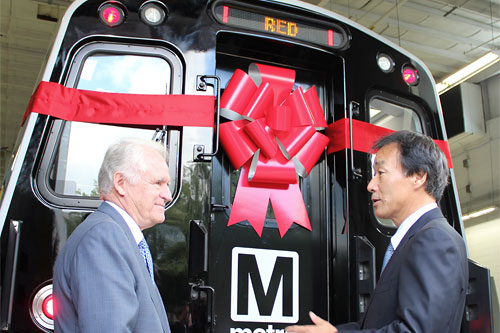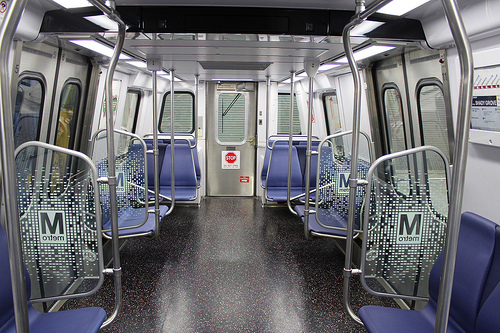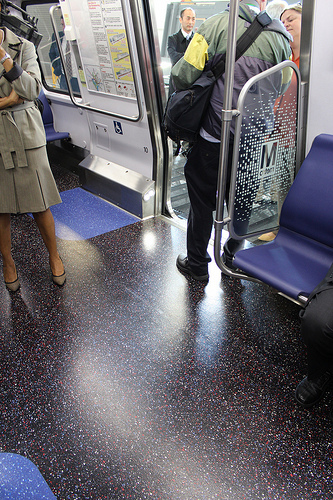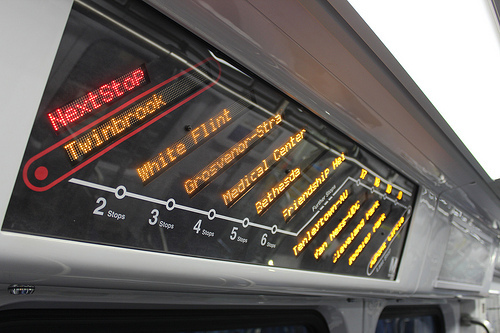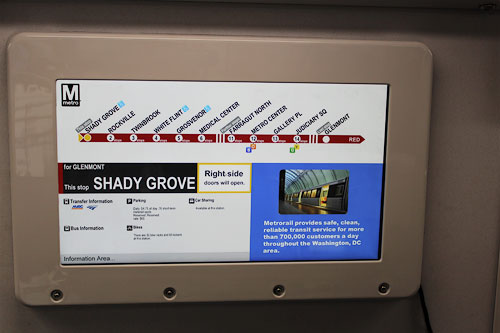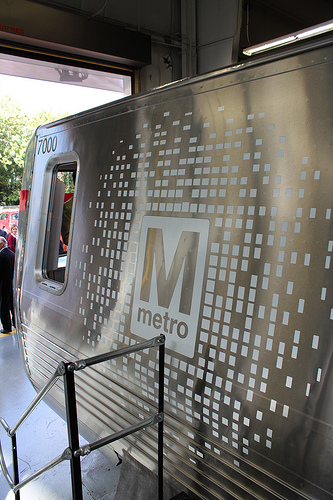Metro’s 7000 series mock-up makes its debut
The newest member of Metro’s fleet recently arrived from Japan, and debuted to reporters this morning at a Metro facility in Landover. The “hard mock-up” is the first of the 7000 series cars to arrive in the Washington area, though this car will likely never carry passengers.
From soft to hard mockups
The new car will allow Metro to make further adjustments to the design of the 7000 series. The agency will be bringing in railcar mechanics, train operators, engineers, and focus groups to help determine whether it needs to change any elements of the design before production begins early next year.
The so-called “hard mock-up” will spend a few weeks here before being moved to Lincoln, Nebraska, where the rest of the 7000 series cars will be assembled. Kawasaki built the mock-up in Japan, and it recently arrived in the United States by ship.
The mock-up is a complete vehicle, including all the necessary electronic and mechanical systems that will be on the rest of the new cars. Currently, the trucks (wheelsets) are not attached to the car body, but they are complete units.
WMATA had earlier built a half-size “soft-mock” to test out different design concepts, and gave the Riders’ Advisory Council and Washington Post a tour. Experiences from the soft-mock influenced the design of this car.
One change, according to spokesman Dan Stessel, came from input from a focus group of disabled riders, who requested that Metro move a pole in the center of the car.
Some more changes may come from to feedback from operators and mechanics. Hopefully, these changes will make the 7000 series cars an even more well-designed addition to WMATA’s fleet.
7000s start a new generation
The 7000 series cars will be far different than the current fleet of railcars. Different enough, in fact, that they won’t be interoperable with the existing fleet of cars.
The new trains will feature several elements that riders should find to be improvements over current cars.
Seats on the new cars have a different shape, giving passengers more legroom. They’re also more ergonomic, according to Metro officials. The new seats have a different surface, that feels like fake leather.
Additionally, by removing the armrests from the seats, Metro has widened the center aisle in the car by 2 inches, which should help riders circulate more easily.
Riders will notice other aesthetic changes to the car as well, especially the lack of carpeting. The 7000 cars will feature a rubber no-slip floor.
According to chief of staff Barbara Richardson, focus groups liked the blue tones featured on the car. They reacted poorly to an updated version of the old cars’ brown palette.
A new display system will help riders know where they are along the line. New York has had a system like this for several years, and it has been well-received there. Each car will include 2 of these digital line maps, which show the next several stations and the final destination of the train.
Additionally, 4 LCD screens on each car will be capable of displaying service information and other announcements. At each station, the screens will automatically show information about connecting transit services and other local information.
The LCD screens could show advertising, though Metro has not yet made a decision about that. The screens are silent, though, so there will be no audio component.
The public address system in the 7000s is digital, rather than the analog system in older cars. This means that announcements should be clearer throughout the train and more easily understandable for riders.
Several cameras have been installed in each car. Each passenger compartment has 4 cameras. Additionally, there are cameras in the operator’s compartment, watching the operator and the control panel and one forward-facing camera.
These cameras will record, so that in the case of an accident or other event, investigators can capture footage. Additionally, the operator can select different cameras using a touch screen if necessary. Whenever someone pushes the emergency intercom, the nearest camera will automatically focus on that area.
Metro Transit Police will have the ability to monitor video feeds from the trains live when necessary.
Doors will now have a single mechanism operating both door leaves, as opposed to the current setup, which has 2. This new design should make the doors more resilient, and less likely to become stuck open. The new door design has fewer moving parts than the doors on the current fleet of cars, and Metro thinks that the simpler design will result in fewer failures and less wear over time. The newer R142 cars on the New York subway use this same door design.
I spoke with Barbara Richardson about changes to the exterior of the car. Gone is the familiar brown stripe. In its place is a new Metro logo surrounded by a pattern of small squares making up a sort of penumbra. Richardson says this logo evokes the way Metro spreads radially into the region.
I wish the “M” logo were more centered with the windows, but I do like the penumbra design. It’s certainly a more modern take on the WMATA logo, which dates back to the early 1970s.
At the unveiling, Metro CEO Richard Sarles thanked Senator Ben Cardin and Congresswoman Donna Edwards. Both were on hand at the event. Sarles thanked elected officials for championing funding for the cars, and noted that without 2008’s PRIIA Act, Metro would have been unable to purchase these cars.
The 7000 series cars represent the largest investment in Metro’s fleet since the rail system started in the mid 70s.
Test track construction is underway
In related news, Metro has started construction of a test track which will allow Metro to prepare the 7000 series cars for service without disrupting the Green Line. This new test track will run alongside the Green Line between the College Park and Greenbelt stations.
Since the test track will lie sandwiched between the CSX and Green Line tracks, Metro has to build crossings over the Green Line to allow construction access. One of these grade crossings, in Berwyn Heights, is mostly complete; Metro built it during the Green Line closure a few weeks ago. A second crossing just south of Greenbelt station is still under construction.

